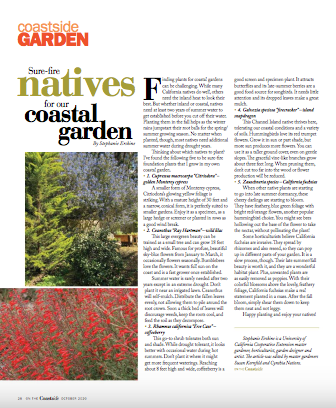Finding plants for coastal gardens can be challenging. While many California natives do well, others need the inland heat to look their best, but whether inland or coastal, natives need at least two years of summer water to get established before you cut their water off. Planting them in the fall helps as the winter rains jumpstart their root balls for the spring/summer growing season. No matter when planted, though, most natives need additional summer water during drought years.
Thinking about which natives to plant? I've found the following five to be sure-fire foundation plants that I grow in my own coastal garden.
1. Cupressus macrocarpa 'Citriodora' – Golden Monterey Cypress
A smaller form of Monterey Cypress, Citriodora's glowing yellow foliage is striking. With a mature height of 30' and a narrow, conical form, it is perfectly suited to smaller gardens. Enjoy it as a specimen, as a large hedge or screener, or planted in rows as a good wind break..
2. Ceanothus 'Ray Hartman' – Wild Lilac
This large evergreen beauty can be trained as a small tree and can grow 18 feet high and wide. Famous for profuse, beautiful sky blue flowers from January to March, it occasionally flowers seasonally. Bumblebees love the flowers. It wants full sun on the coast and is a fast grower once established.
Summer water is rarely needed after two years except in an extreme drought. Don't plantit near an irrigated lawn. Ceanothus will self-mulch. Distribute the fallen leaves evenly, not allowing them to pile around the root crown. Soon a thick bed of leaves will discourage weeds, keep the roots cool, and feed the soil as they decompose.
3. Rhamnus californica 'Eve Case' – Coffeeberry
This go-to shrub tolerates both sun and shade. While drought tolerant, it looks better with occasional water during hot summers. Don't plant it where it might get more frequent waterings. Reaching about 8 feet high and wide, Coffeeberry is a good screen and specimen plant. It attracts butterflies, and its late-summer berries are a good food source for songbirds. It needs little attention and its dropped leaves make a great mulch.
4. Galvezia speciosa 'Firecracker' – Island Snapdragon
This Channel Island native thrives here, tolerating our coastal conditions and a variety of soils. Hummingbirds love its red trumpet flowers. Grow it in sun or part shade, but more sun produces more flowers. You can use it as a taller ground cover, even on gentle slopes. The graceful vine-like branches grow about three feet long. When pruning them, don't cut too far into the wood or flower production will be reduced.
5. Zauschneria species – California Fuchsias
When other native plants are starting to go into late summer dormancy, these cheery darlings are starting to bloom. They have feathery, blue green foliage with bright red/orange flowers, another popular hummingbird choice. You might see bees hollowing out the base of the flower to take the nectar, without pollinating the plant!
Some horticulturists believe California fuchsias are invasive. They spread by rhizomes and also reseed, so they can pop up in different parts of your garden. It is a slow process, though. Their late summer/fall beauty is worth it, and they are a wonderful habitat plant. Plus, unwanted plants are as easily removed as poppies. With their colorful blossoms above the lovely, feathery foliage, California fuchsias make a real statement planted in a mass. After the fall bloom, simply shear them down to keep them neat and not leggy.
Happy planting and enjoy your natives!
Stephanie Erskine is a UC Master Gardener, horticulturist, garden designer, and artist. The article was edited by UC Master Gardeners Susan Kornfeld and Cynthia Nations
Attached Images:
